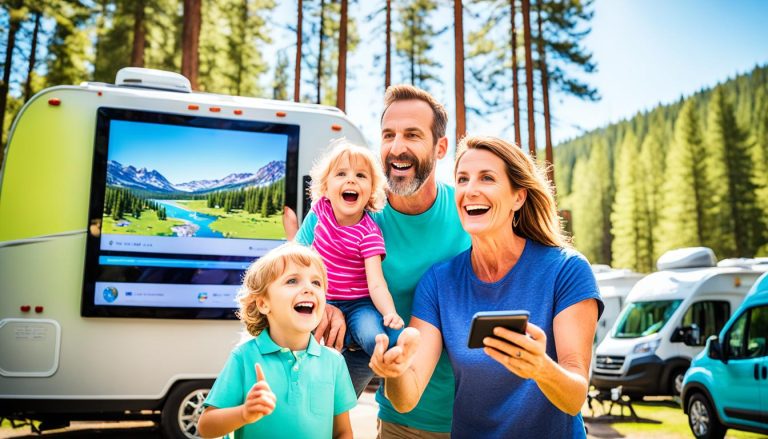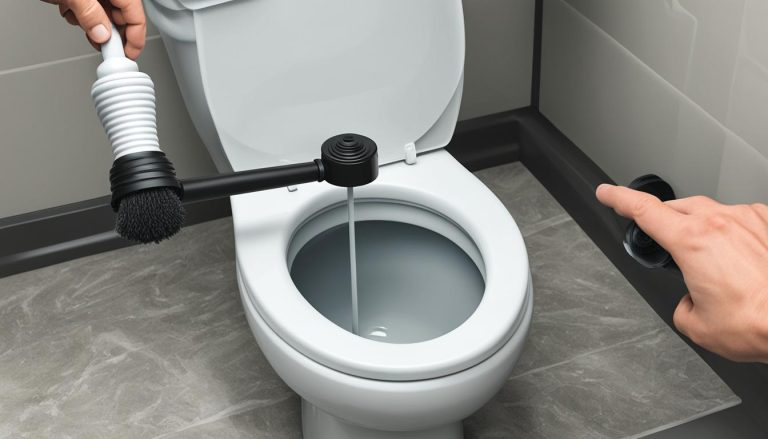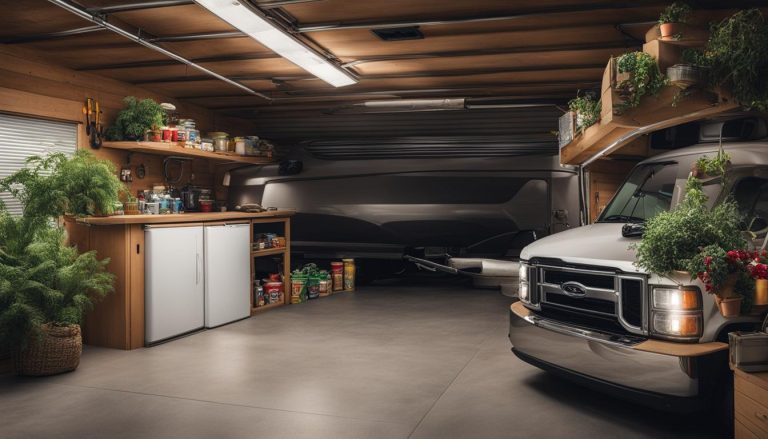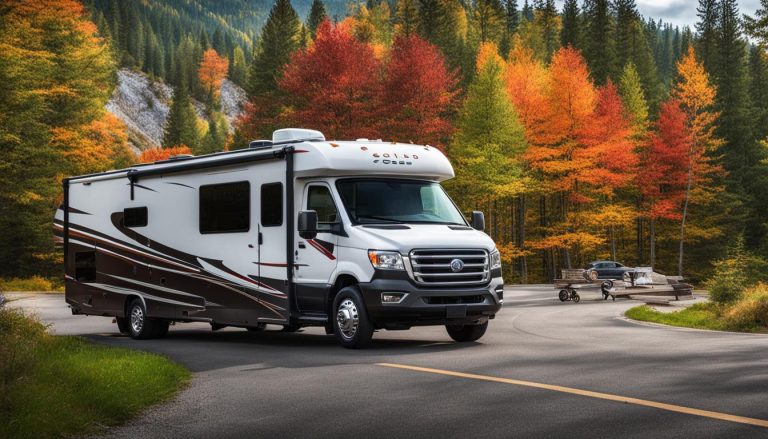Connect RV Batteries Easily: Step-by-Step Guide
gorvlifestyle.com and its partners may earn a commission if you purchase a product through one of our links
Welcome to our step-by-step guide on how to connect RV batteries. Whether you’re a seasoned RVer or new to the world of recreational vehicles, understanding how to effectively connect and maintain your RV batteries is essential for a smooth and enjoyable camping experience.
When it comes to connecting RV batteries, there are a few key factors to consider. First and foremost, it’s important to ensure that the batteries have the same voltage and capacity rating. This ensures that they work together efficiently and prevents any potential damage to the batteries or your RV’s electrical system.
There are three primary ways to connect RV batteries: series, parallel, or a combination of both. Series connections increase voltage while maintaining the same capacity, parallel connections increase capacity while keeping the voltage the same, and series-parallel connections combine the two.
When connecting batteries, always use jumper wires to connect the positive and negative terminals correctly. This ensures that the batteries are connected in the desired configuration and helps avoid any potential short-circuits. It’s also crucial to use batteries of the same capabilities and avoid mixing and matching different battery sizes.
Key Takeaways:
- Ensure that the batteries have the same voltage and capacity rating.
- Choose between series, parallel, or series-parallel connections based on your specific needs.
- Use jumper wires to connect the positive and negative terminals correctly.
- Avoid mixing and matching different battery sizes.
- Regularly monitor and maintain your RV battery system for optimal performance.
Understanding Series Connections for RV Batteries
In a series connection, the voltage of the batteries is added together while the capacity remains the same. This is useful when you need to increase the voltage of your battery bank. To connect batteries in series, use a jumper wire to connect the negative terminal of the first battery to the positive terminal of the second battery. It’s important to note that when using a series connection in an RV, make sure to use the correct battery voltage for your specific setup.
Additionally, it’s crucial to be aware of the difference between 12V and 6V batteries and how they should be wired differently in series connections.
Comparison of Series and Parallel Connections
| Series Connection | Parallel Connection | |
|---|---|---|
| Voltage | Increases | Remains the same |
| Capacity | Remains the same | Increases |
| Total Power | Increases | Increases |
| Wiring | Connect positive of one battery to negative of another | Connect positive terminals together, negative terminals together |
Exploring Parallel Connections for RV Batteries
Parallel connections are a great way to increase the capacity of your RV battery bank while maintaining the same voltage. This method comes in handy when you need to enhance the overall power capacity of your RV power system. By connecting batteries in parallel, you’ll be able to maximize your RV’s electrical capabilities.
To establish a parallel connection, you’ll need to use jumper wires to connect the positive terminals of the batteries together and the negative terminals together. This ensures that the power flows uniformly across all batteries, resulting in a balanced and efficient system.
It’s important to note that when connecting batteries in parallel, you should use cables that are heavy enough to handle the increased amperage. This will prevent any potential issues related to overheating or power loss.
To keep your RV battery system operating at its best, regular maintenance is essential. Routine cleaning of the battery terminals helps prevent corrosion and ensures proper electrical conductivity. Checking the water levels in each battery and topping them up as needed is also crucial for their overall performance and longevity.
Monitoring the battery charging process is another important aspect of RV battery maintenance. Not only does this help prevent overcharging or undercharging, but it also allows you to detect any potential issues with the charging system early on.
Remember: Taking good care of your RV batteries through regular maintenance will help ensure their optimal performance and extend their lifespan, allowing you to enjoy your adventures worry-free.
Advantages of Parallel Connections for RV Batteries:
- Increased overall capacity of the battery bank
- Maintains the same voltage for compatibility with RV electrical systems
- Enhanced power availability for running multiple appliances simultaneously
Key Steps for Parallel Connections:
- Use jumper wires to connect the positive terminals together
- Connect the negative terminals together using separate jumper wires
- Ensure cables are heavy enough to handle the increased amperage
- Regularly clean the battery terminals to prevent corrosion
- Check and refill water levels in each battery as needed
- Monitor the battery charging process for optimal performance
Harnessing the Power of Series-Parallel Connections
Series-parallel connections offer a unique advantage in RV battery setups, combining the benefits of both series and parallel connections. This configuration allows for an increase in both voltage and capacity, making it ideal for powering appliances and systems that require higher voltage levels.
To create a series-parallel battery bank, you need to connect each set of batteries in series and then parallel the sets together. This arrangement ensures a balance between voltage and capacity, providing a reliable and efficient power source for your RV.
When setting up a series-parallel connection, it is crucial to pay attention to the size and capacity of cables and connections. Ensure that they are properly sized and can handle the increased amperage. This will help prevent overheating, voltage drop, and potential damage to your battery system.
Proper battery charging is essential for maintaining the health and performance of your RV battery setup. It’s important to follow the manufacturer’s guidelines for charging and regularly monitor the battery’s charging process to prevent overcharging or undercharging. This will help prolong the lifespan of your batteries and ensure optimal performance.
Here’s an image that illustrates the series-parallel connection in an RV battery setup:

Benefits of Series-Parallel Connections:
- Flexibility: Series-parallel connections provide the flexibility to meet the power requirements of various appliances and systems in your RV.
- Increased Voltage: By connecting batteries in series, you can increase the overall voltage of your battery bank, allowing you to power high voltage appliances.
- Enhanced Capacity: Parallel connections boost the capacity of the battery bank, enabling you to store more energy and power multiple devices for longer periods.
- Efficiency: Series-parallel connections ensure a balance between voltage and capacity, optimizing the efficiency of your RV battery system.
Expert Tip:
“When setting up a series-parallel connection, double-check all the connections and ensure that each battery is of the same voltage and capacity. This will help maintain a balanced and reliable power supply for your RV.”
Incorporating series-parallel connections into your RV battery setup can significantly enhance your overall power capabilities. Whether you need to power high voltage appliances or increase your battery’s capacity, this configuration offers a versatile solution. By understanding the principles of series and parallel connections, you can harness the full potential of your RV battery system and enjoy a reliable power source on your adventures.
Troubleshooting RV Battery Connections
When it comes to RV battery troubleshooting, it’s crucial to address any issues promptly to ensure your battery system functions optimally. Here are some essential steps to troubleshoot common RV battery connection problems.
1. Check for Loose or Corroded Connections
A common issue with RV batteries is loose or corroded connections. Make sure to inspect all cables and terminals for tightness and cleanliness. If you notice any corrosion, clean it off using a battery terminal cleaner. This will help ensure a secure and reliable connection.
2. Examine Cables for Damage or Wear
Inspect the cables connected to your RV batteries for any signs of damage or wear. Look for frayed insulation, exposed wires, or cracks in the cable. Damaged cables can lead to poor battery performance or even potential safety hazards. If you spot any issues, it’s recommended to replace the damaged cables promptly.
3. Test Each Battery Individually
If your battery bank is not providing the expected voltage or capacity, it may be necessary to test each battery individually. Use a multimeter to measure the voltage of each battery and compare it to the manufacturer’s specifications. This will help you identify any faulty batteries that need to be replaced.
4. Monitor the Charging Process
Monitoring the charging process is essential for maintaining the health and longevity of your RV batteries. Keep an eye on the battery charger to ensure it is functioning correctly and providing the right voltage and current. Regularly check the battery levels and make sure they are within the recommended range.

“By troubleshooting your RV battery connections, you can identify and resolve any issues before they escalate, ultimately ensuring a reliable and efficient power supply for your RV adventures.”
By following these troubleshooting tips, you can identify and resolve RV battery connection issues, allowing you to enjoy uninterrupted power during your RV trips. Regular maintenance and monitoring of your battery system will help extend its lifespan and optimize its performance.
Tips for Optimal RV Battery Connection
When it comes to RV battery connections, following a few key tips can help ensure optimal performance and longevity. Start by using high-quality batteries that are properly matched in voltage and capacity. This ensures seamless cooperation between the batteries, maximizing efficiency.
In addition, it’s vital to use heavy-duty cables that are appropriately sized for your RV power system’s amperage requirements. This minimizes voltage drop and guarantees maximum performance. Remember, choosing the right cables is just as important as selecting the right batteries.
Ongoing monitoring and maintenance are also essential for your RV battery setup. Regularly check the water levels, clean the terminals, and keep a close eye on the charging process. This proactive approach allows you to identify any issues early on and maintain a reliable and efficient RV battery system for your adventures.
FAQ
How do I connect my RV batteries?
To connect your RV batteries, follow this step-by-step guide, which explains how to connect batteries in series, parallel, or a combination of both. Make sure to use jumper wires to connect the positive and negative terminals correctly and avoid short-circuiting the batteries. Additionally, ensure that the batteries have the same voltage and capacity rating.
What is the difference between series and parallel connections for RV batteries?
In a series connection, the voltage increases while the capacity remains the same. This is useful when you need to increase the voltage of your battery bank. In a parallel connection, the capacity increases while the voltage remains the same. This is helpful when you need to increase the overall capacity of your RV power system.
How do I connect batteries in series?
To connect batteries in series, use a jumper wire to connect the negative terminal of the first battery to the positive terminal of the second battery. Make sure to use the correct battery voltage for your specific RV setup.
What is the correct way to connect batteries in parallel?
To connect batteries in parallel, use jumper wires to connect the positive terminals together and the negative terminals together. Ensure that the cables used in the parallel connection are heavy enough to handle the increased amperage.
How do I create a series-parallel battery bank?
To create a series-parallel battery bank, first, connect each set of batteries in series, and then parallel the sets together. This combination allows for an increase in both voltage and capacity.
How can I troubleshoot RV battery connections?
When troubleshooting RV battery connections, check for loose or corroded connections, ensure that all cables are securely attached, and test each battery individually if the battery bank is not performing as expected. Regular maintenance and monitoring of the charging process are also important.
What tips can you provide for optimal RV battery connection?
Always use high-quality batteries that are properly matched in voltage and capacity. Use heavy-duty cables that are properly sized to handle the amperage requirements of your RV power system. Regularly monitor and maintain your RV battery system by checking water levels, cleaning terminals, and monitoring the charging process.






